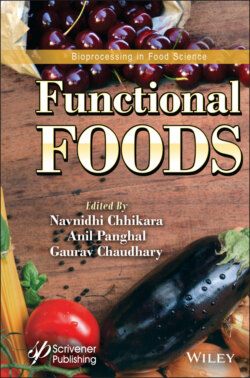Читать книгу Functional Foods - Группа авторов - Страница 22
1.4.4 Seafood, Meat and Poultry Based Functional Foods
ОглавлениеFish is an important component of staple diet of large population groups and provides high quality protein, lipids, vitamins and minerals. Fish is richest source of omega-3- polyunsaturated fatty acids predominantly docosahexaenoic (DHA) and eicosapentaenoic (EPA) accounting for various health promoting and disease preventing benefits like cardiovascular disease, asthma, cancer, hay flashes, lungs abnormalities, kidney dysfunctionality, migraine, hypertension, rheumatoid arthritis and skin infections etc. [59]. Fish protein powder and meal are used as functional ingredient as dispersing agent, binder and emulsifier in different preparations like restructured meats, fillet blocks, soups, baked products, extruded snacks, noodles etc. [60–64]. Different marine sources like fish, crab shells, crustaceans are considered as good source of various nutrients. Different parts like fish bones, fins, heads and internal organs generally considered as waste contain abundant amount of calcium [65]. So these can be used as functional ingredient in different food formulations. Choi et al. [66] used oyster shell calcium powder for improvement of chewiness and springiness in restructured ham.
Muscle foods contain abundant amount of various nutrients and bioactive compounds e.g. iron, zinc, conjugated linoleic acid (mainly ruminants), taurine, creatine, L-carnitine, indispensible amino acids, and B vitamins and are classified as red meat, fish, poultry and processed meat [67, 68]. Consumer demand for meat products with incorporated functional ingredients has also seen a sharp rise in recent years [69]. Increased health awareness in consumer has created urge for meat with low salt content, nitrates and nitrites, fat and cholesterol [70].
Eggs are rich source of protein, lipids, vitamin A, D, E, K, B1, B9 and B12, choline, selenium, iron and phosphorous etc. Now a day, egg is also recommended as healthy diet for weight management and good health. Lipids profile of egg includes phospholipids (29%) mainly in the form of phosphatidylcholine and phosphatidylethanolamine, triglycerides (65%), cholesterol (5%) and free fatty acids (<1%). The consumption of egg has been suggested due to antioxidant activity, immune modulation and activation, anti-cancer treatment, antihypertensive activity, antigenic activity, antiviral activity, antimicrobial activity [71]. Choline present in egg play important role in development of brain, better liver functionality and prevents cancer also. Egg is preferred as functional food as it is rich in protein, provides moderate calories, low in cost and can be used in various culinary forms [72]. The functionality of eggs has been improved by feeding the layer hen with diet rich in omega -3- fatty acids [73]. Such eggs are appropriate and approach to avail the health benefits of omega 3 fatty acids without any medications, dietary supplements and alteration in dietary habits [74]. The consumption of egg fortified with omega-3- polyunsaturated fatty acids is associated with cardioprotective effect, anti-atherosclerosis, anti-thrombosis and maintains blood pressure also [75–77].
